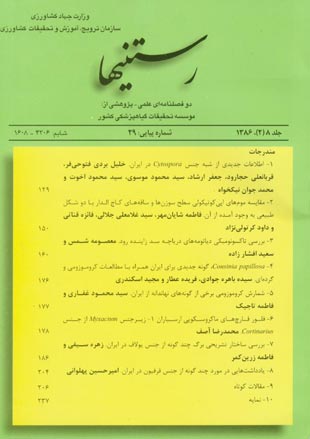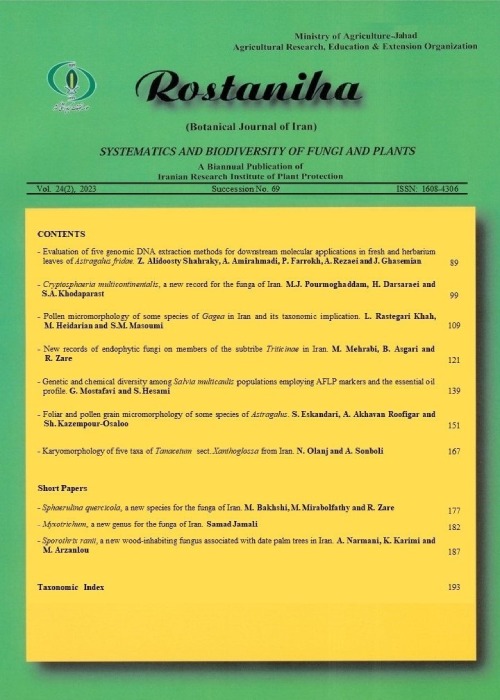فهرست مطالب

نشریه رستنیها
سال هشتم شماره 2 (پیاپی 29، پاییز و زمستان 1386)
- 200 صفحه،
- تاریخ انتشار: 1386/12/13
- تعداد عناوین: 10
-
-
صفحه 129به منظور مطالعه تاکسونومیکی شبه گونه های شبه جنس Cytospora، حدود 400 نمونه از سراسر ایران طی سالهای 1382 تا 1384 جمع آوری گردید. در مقاله حاضر، بخش اول نتایج این مطالعه شامل معرفی هفت شبه گونه آورده شده است. شبه گونه های Cytospora atrocirrhata، C. carbonacea، C. gutnerae، C. nivea وC. rosarum اعضای جدیدی برای فلور قارچ های ایران می باشند. Vitis vinifera برای C. leucostoma و همچنینCeltis australis و Populus albaبرای C. translucens به عنوان میزبان های جدید (matrix nova) گزارش می شوند.
کلیدواژگان: قارج، تاکسونومی، تنوع زیستی، Coelomycetes -
صفحه 150پژوهش حاضر روی ویژگی های میکروموفولوژی موم و کوتیکول سوزن ها و ساقه کاج های الدار (Pinus eldarica)، کله قندی و توپی انجام شده است. نتایج میکروسکوپ SEM نشان داد که سطح ساقه و اتاقک های زیر روزنه با کریستال های موم لوله ای در هر سه نوع کاج پوشیده شده است. سطح زیرین سوزن ها نیز که بیشتر توسط موم های بی شکل یا ورقه ای پوشیده شده، از نظر مقدار و نیز ساختار در کاج توپی با سایرین متفاوت بوده است. اما بارزترین تفاوت مربوط به سطح رویی سوزن های کاج توپی بوده که از نظر ساختار نسبت به دو کاج دیگر متکامل تر به نظر می رسد. در این سطح، کریستال های لوله ای روی توده های بی شکل موم به چشم می خورند در حالی که در کاج الدار، موم ها اغلب بی شکل یا ورقه ای هستند و کاج کله قندی نیز دارای گرانول های به هم پیوسته می باشد. نتایج این تحقیق حاکی از نوعی سیر تکاملی موم ها از کاج الدار به سمت کله قندی و توپی است.
کلیدواژگان: میکرومورفولوژی، کریستال های لوله ای، کوتیکول، کاج توپی، کاج کله قندی -
صفحه 160نمونه برداری از دیاتومه های دریاچه سد زاینده رود در چهار ایستگاه از سطح آب و عمق های 5/ 0 و 3 متر در سه تکرار با استفاده از دستگاه Nansen و از سطح توسط تور پلانکتون گیری انجام شد. نمونه ها با فرمالین 4% تثبیت و پس از تغلیظ توسط کلیدهای ویژه شناسایی شدند. آنالیزهای فیزیکوشیمیایی آب توسط روش های استاندارد صورت گرفت.
بر اساس نتایج این تحقیق 53 گونه متعلق به 23 جنس از شاخه Bacillariophyta شناسایی گردید و جنس Nitzschia بیشترین تعداد گونه را در منطقه مورد مطالعه داشته است و دیاتومه Cyclotella meneghiniana گونه غالب در تمام دوره مطالعه بود. به طور کلی، با توجه به تغییرات فصلی، حالت های غذایی و تروفیک، تراکم مناطق مسکونی و ویلاها ترکیب گونه ای دیاتومه ها دستخوش تغییر است. با توجه به آنالیزهای فیزیکوشیمیایی و مطالعات تاکسونومیکی و وجود بعضی گونه های خاص می توان چنین نتیجه گرفت که دریاچه زاینده رود الیگو مزوتروف می باشد.
کلیدواژگان: دیاتومه ها، دریاچه سد زاینده رود، الیگو، مزوترف، ایران -
صفحه 176گونه Cousinia papillosa (Asteraceae)، به عنوان گونه جدیدی از شرق ایران معرفی می گردد. اختلافات موجود بین این گونه و نزدیک ترین خویشاوند آن Cousinia meshhedensis مورد بحث قرار می گیرد. نقشه پراکنش هر دو گونه ارایه گردیده است. مطالعات گرده ای اختلاف بین دو گونه را کاملا نشان می دهد. شمارش کروموزومی برای گونه جدید انجام گرفته است (13=n).
کلیدواژگان: Asteraceae، Coustinia، مطالعات کروموزومی، مطالعه گرده ای -
صفحه 177مشاهدات کروموزومی برای 17 گونه متعلق به 12 تیره ارایه شده است. شمارش کروموزومی گونه (Amberboa nana، n=16 (Asteraceae و زیرگونه Camelina rumelica subsp. transcapica، n=13 (Brassicaceae) برای اولین بار گزارش شده است. شمارش کروموزومی برای شش گونه شامل: Rhagadiolus stellatus (n=5)، Campanula raponcoloides (n=34)، Campanula trachelium (n=10)، Helianthemum salicifolium (n=10)، Sorghum halepense (n=20)وConsolida (orientalis (n=8 برای فلور ایران جدید می باشد. همچنین سطح تتراپلوییدی n=12 برای گونه Linaria simplex نیز برای اولین بار ارایه شده است.
کلیدواژگان: نهاندانه، شمارش کروموزومی، میوزی، میتوزی -
صفحه 178بخش تحقیقات رستنی ها، موسسه تحقیقات گیاهپزشکی کشور در این مقاله، چهار گونه متعلق به زیرجنس Myxacium از جنس Cortinarius به اسامی: C. arvinaceus، C. causticus، C. erumpens و C. pluviorum جمع آوری شده از ارسباران، برای نخستین بار از ایران گزارش می گردند. گونه نخست به بخش Defibulati و سه گونه دیگر به بخش Ochroleuci از زیرجنس Myxacium تعلق دارند.
کلیدواژگان: تنوع زیستی، ایران، قفقاز، آذربایجان شرقی، Agaricales -
صفحه 186در تحقیق حاضر، صفات تشریحی برگ هفت گونه از جنس یولاف (Avena) با استفاده از میکروسکوپ نوری و میکروسکوپ الکترونی (SEM) مورد بررسی و تجزیه و تحلیل قرار گرفت. این گونه ها عبارتند از: A. barbata، A. clauda، A. eriantha، A. fatua، A. ludoviciana، A. sativaو A. wiestii. نتایج حاصل از مشاهدات نشان می دهد صفات تشریحی مانند تعداد یاخته های حبابی، ضخامت پهنک، برجستگی آوند میانی، تعداد دسته های آوندی از آوند میانی تا حاشیه برگ و برخی دیگر از صفات تشریحی در تفکیک گونه ها کارآمد هستند. با توجه به شباهت های مورفولوژیکی بین گونه های این جنس، نتایج تشریحی در جهت تفکیک گونه ها مورد استفاده قرار گرفت. بر اساس صفات مشاهده شده کلید شناسایی گونه های جنس یولاف در ایران تدوین گردید و کلید شناسایی بر اساس صفات مورفولوژیکی نزدیکی گونه ها را از نظر آناتومیکی تایید می کند.
کلیدواژگان: یولاف (جو دوسر)، آناتومی برگ، گندمیان -
صفحه 204تیره فرفیون (Euphorbiaceae) با حدود 8000 گونه یکی از تیره های بزرگ گیاهان گلدار در جهان به شمار می رود. در این تیره، جنس فرفیون با بیش از 2000 گونه یکی از بزرگترین جنس های جهان به شمار می رود که در سراسر کره زمین، از مناطق گرمسیری، نیمه گرمسیری تا معتدله پراکنده هستند. این جنس در ایران بالغ بر 80 گونه دارد که تعدادی از آن ها انحصاری ایران و جزو گونه های نادر و احیانا در حال انقراض و تعدادی به صورت مهاجم و علف هرز در سراسر ایران پراکنده هستند. در این تحقیق سه آرایه از جنس مذکور به عنوان مترادف، یک آرایه به عنوان گزارش جدید و یک آرایه به عنوان کشف مجدد و جالب برای فلور ایران گزارش و شرح داده می شوند. گونه های مورد نظر به ترتیب عبارتند از:Euphorbia chamaepeplus Boiss. et Gaill.، Diagn. Ser. 2، 4: 88، 1859Euphorbia decipiens Boiss. & Buhse، Nouv. Mem. Soc. Nat. Mosc. 12: 197، 1860 Euphorbia grossheimii Prokh. in Izv. Glavn. Bot. Sada S.S.S.R. 29: 551، 1930 Euphorbia sahendi Bornm.، Verh. Zool. Bot. Ges. 60: 171، 1910Euphorbia deltobracteata Prokh.، Consp. Syst. Tithym. Asiae Mediae 149، 1933 در هر مورد شرح دقیق و تصویری از هر گونه به همراه اطلاعاتی از رویشگاه، پراکنش در ایران و جهان و در صورت لزوم مقایسه با گونه نزدیک به آن در ایران ارایه می شود.
کلیدواژگان: بومی، کشف مجدد، رکورد جدید، گونه کمیاب، مترادف، فلور ایران -
صفحه 206
-
صفحه 237
-
Page 129In order to study of the form-genus Cytospora, around 400 specimens were collected from all over the Iran during 2003-2005. In this paper, the first part of the obtained results, including seven form-species are presented. Cytospora atrocirrhata, C. carbonacea, C. gutnerae, C. nivea and C. rosarum are reported as new members for mycoflora of Iran. Also, Vitis vinifera for C. leucostoma and Celtis australis and Populus alba for C. translucens are reported as new hosts (matrix nova) in the world.Keywords: Fungi, Taxonomy, Biodiversity, Coelomycetes
-
Page 150Plant cuticles are covered by epicuticular waxes with considerable ultrastructural and chemical diversity and have great systematic significance. Pinus elderica is a rare pine found naturally only in desert environment southeast of Tbilisi (Georgia). This tree have been probably introduced to Iran about 800 years ago and gradually altered in both shape and size in Nashtifan-Khaf, and changed into two forms of conical and ball-shaped with smaller stature, which are known as these names. This study, was conducted on wax and cuticle micromorphological features of aforesaid pines needles and stems. SEM results showed that, stem and epistomatal chambers surface was covered with tubular wax crystalloids in all three pines. The abaxial surface of needles, covered by amorphous or layers wax structures, was different in ball-shaped pine with others.Keywords: Micromorphology, Tubular crystalloids, Cuticle, Ball, shaped pine, Conical, shaped pine
-
Page 160Diatoms samples in Zayandeh Rood Dam Lake were taken in four stations from surface, 0.5 and 3 m depths of water in three replicate by Nansen sampler. Additional samples were taken from the surface with plankton net. Diatoms samples fixed with 4% formaldehyde and were concentrated and identified using microscope at 400 x. Salinity, NO3, PO4 and SO4 were measured using standard methods (APHA). In the present study, 53 species and 23 genera were identified. Nitzschia was dominant genera with 12 species and Cyclotella meneghiniana Kutz. was dominant species in all stations and seasons. Temperature, pH, EC and DO were measured at site. The study revealed that, the Zayandeh Rood Dam lake is an oligo- mesotrophic water body.Keywords: Diatoms, Zayandeh Rood Dam Lake, Oligo, mesotroph, Iran
-
Page 176Cousinia papillosa (Asteraceae) from eastern Iran is described and illustrated as a new species. Differences between the new species and its closest relative, C. meshhedensis, are discussed. A map showing the distribution of the two species is given. The scanning electron micrography of the pollen grains shows obvious differences between the two species especially in the sculpturing of exine. The meiotic chromosome count is also reported (n=13).Keywords: Cousinia, Asteraceae, palynological studies, chromosome studies, new species, Iran
-
Page 177Original meiotic or mitotic chromosome counts are presented for 17 species in 12 families of angiosperms from Iran. Chromosome counts for Amberboa nana, n=16 (Asteraceae) and Camelina rumelica subsp. transcapica, n=13 (Brassicaceae) are repoted for the first time. Chromosome numbers for six species including: Rhagadiolus stellatus (n=5), Campanula raponcoloides (n=34), Campanula trachelium (n=10), Helianthemum salicifolium (n=10), Sorghum halepense (n=20), Consolida orientalis (n=8) are new reports for the flora of Iran. Also, the tetraploid level of n=12 for Linaria simplex is reported here for the first time.Keywords: Angiosperm, Chromosome count, Meiotic, Mitotic
-
Page 178Due to the importance of the Arasbaran forest (E. Azarbaijan, N.W. Iran) as a biosphere preserve and having a rich flora and fauna, macrofungi flora of Arasbaran region, were studied from 2003. This is the first in a series of publications on floristic studies of macrofungi of Arasbaran forests. In this paper, species of the genus Cortinarius, subgenus Myxacium are studied.The genus Cortinarius Fr. is largest genus of gilled basidiomycete fungi. There are about 2000 species epithets for this genus in the world. The following characters delimit Cortinarius taxa: (i) a rusty brown to ochraceous spore print, (ii) spores lacking a germ pore and (iii) a cortinate veil. Cortinarius spp. form ectomycorrhizal associations with plants and also some species have been considered as poisonous mushrooms.Keywords: Biodiversity, Iran, Caucasia, E. Azarbaijan, Agaricales
-
Page 186In this research foliar anatomy of seven species of Avena are studied under the light microscope and the scanning electron microscope (SEM). This study includes seven species, namely, A. barbata, A. clauda, A. eriantha, A. fatua, A. ludoviciana, A. sativa and A. wiestii. Different anatomical characters sush as number of bulliform cells, mesophyll thickness, midrib, number of vascular bundles from midrib to margin and some other characters are efficient in identification of species. Anatomical results are applied in separation of species from each other. The identification key based on anatomical characters is also presented. It is concluded that, the identification key based on morphological characters supports the relation between species based on anatomy.Keywords: Avena, Foliar anatomy, Poaceae
-
Page 204During the study on newly collected and herbarium specimens belonging to the genus Euphorbia, three species, namely, E. gorenfloti, E. cheirolepioides and E. splendida were found to be synonymous with E. chamaepeplus, E. grossheimii and E. decipiens, respectively. Euphorbia sahendi as an interesting and rare species has been recognized after long time again among my material and Euphorbia deltobracteata is reported as a new record for the flora of Iran. Morphological characteristics, distribution, phytochoria and habitat of each species are reported. All these species are also illustrated.Keywords: Endemic, New record, Rare plant, Reinvestigation, Synonymous, Flora of Iran


